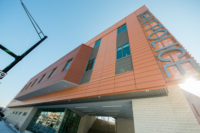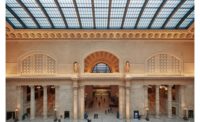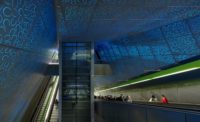The Village of Glen Ellyn, Illinois, placed its police station inside the Civic Center four decades ago. At the time, planners believed the construction of a better station was imminent. More than 30 years later, it was still there — in an 11,000 square-foot space that prohibited efficient work flow. Community members, police and suspects all entered through the same parking lot and interviews were conducted next to administrative offices. There were obvious safety and privacy concerns about this arrangement and a new, improved station was long overdue.
After reviewing several methods and systems, new advancements in masonry wall systems seemed the most logical choice, according to Jonathan Tallman, regional public safety director for Dewberry, and project manager and project guide for the Glen Ellyn police station project. They also found that masonry gave them the flexibility to create a design that complemented the natural setting.
In 2011, the village was financially ready and issued an RFP for design firms with experience in public safety projects. They chose experienced companies, Dewberry, an engineering consultant firm based in the Chicago area and Leopardo Construction of North Aurora, Illinois. A design team from Dewberry conducted a needs-based assessment over several months. They determined it was difficult to have all needs addressed in one space, and ruled out renovating the existing site. The study then identified a location near village-owned Panfish Park as having the most opportunities of the various sites available. Among other benefits, this more centralized location gives police and community member’s better, safer access to each other. The Panfish site is also closer to the road with the highest volume of accidents and other calls for service, so police can respond to the bulk of their calls more quickly.
The design team weighed the needs study against the budget of $13.16 million and determined some features should be postponed as future additions, such as a firing range and weapons training annex, as well as a parking garage.
With site and needs defined, Leopardo then conducted the site analysis. The tests ruled out the possibility of including a basement and identified a flood plain that also made it impossible to site the building exactly where designers wanted. Further complicating matters, the Army Corps of Engineers then moved the flood plain a month or two into the design process.
“It turned out to be a big flood plain, so we moved the building closer to Park Boulevard, a lot closer to the street than we’re used to,” says Tallman, He notes this created a 25-foot setback instead of the usual minimum of 50-feet, so they added signs, bollards and trees to the design to protect the building from accidents such as a car jumping a curb.
Aside from working around constraints presented by a site, Dewberry typically relies on the location to help lend vision and inspiration to the overall design. “We look at the materials, styles and forms that already exist at and around the intended building site for considerations,” said Tallman. “In the case of Glen Ellyn Police Station, it was a park setting and the station needed to reflect that more natural setting, more so than a typical brick office building would.”
Another key site consideration for the building was the fact that its surroundings were diverse, and it would be visible from all sides. There are residences across the street, adjacent to the park. A commercial-looking doctor’s office is located to the North, and the East side where Panfish Park lies is all grass, paths and a pond. The South side of the building was designated public parking.
“It was important, then, that it look nice from all sides, not just from the front,” said Tallman. Designers initially considered natural stone but then learned that choosing the right stone veneers could provide savings without sacrificing beauty. The stone looks along with wood beams placed in long, linear lines on the exterior worked well, to complement and blend nicely with the park’s woodland scenery. Leopardo recommended using Oldcastle’s Echelon Cordova Stone to achieve natural looks at a more budget-friendly price.
“It was a good cost alternative that will last a long time like stone and look as natural,” he says.
Leopardo also identified certain walls on which they could save money by substituting Echelon InsulTech from Oldcastle APG, an Insulated concrete masonry system (ICMS) for steel column framing and infill block. Echelon’s Cordova and Mesastone were installed using the InsulTech wall system for the detention, sally port and garage areas on the North side of the building.
“The InsulTech walls were the first areas completed on the building,” points out Tallman.
“Once the masons got going on the structural wall, they were able to finish it all with the three-in-one system.”
InsulTech is a complete, thermally broken insulated masonry system which includes a full complement of insulation, blocks and concrete masonry units (CMUs). Internal stainless-steel metal anchors molded into EPS inserts also provide wind-load resistance and fire safety. The system provided Dewberry design flexibility, while saving the village time and money both on installation costs and long-term energy costs.
Tallman adds, “It also was a big cost benefit to owner not to spend money on concrete for the detention area — which they would have had to do — and then also pay for a finish.”
“Having the masonry go up really fast was one of the contributing factors to being done two months ahead of schedule,” says Tallman.
With the project running under budget, the village also was able to install elements that had originally been removed from the plan, including a fence, security cameras and storage units.
The workflow of the new station is much improved. To make sure the two-story design didn’t impede interaction among police officers and administration, designers created a general hub area. “We refer to it as ‘forced collision,’ because there are spaces such as the staff entrance and the break room that everyone in the building will at some point of the day pass through or stop in,” says Tallman.
To make the building truly the community’s asset, its two-story lobby serves as a community room with a 175-person capacity. This space carries the natural aesthetic inside, and windows are placed to maximize park views. The community room’s windows also automatically tint when sun streams through. This space has become so popular the village had to restrict groups from making standing reservations years in advance to allow enough opportunity for everyone to use it.
“Police stations should be a place where people want to go, to talk with a police officer if something bothers them,” said Tallman. “This building’s open and welcoming style makes the police within it more approachable.”
The more centralized location, strategic layout and design that complements the many elements of its surroundings better meet the police and community’s needs for the station. They are also more in keeping with what the village intended decades ago.
“The original station’s plans from 1977 say ‘temporary’ on them. It was never intended to be the permanent station through 2016,” said Tallman. “This is long overdue for the village and its residents and we’re happy to have helped them finally achieve it.”
For more information about Echelon Masonry and InsulTech wall systems, visit www.EchelonMasonry.com.







Report Abusive Comment